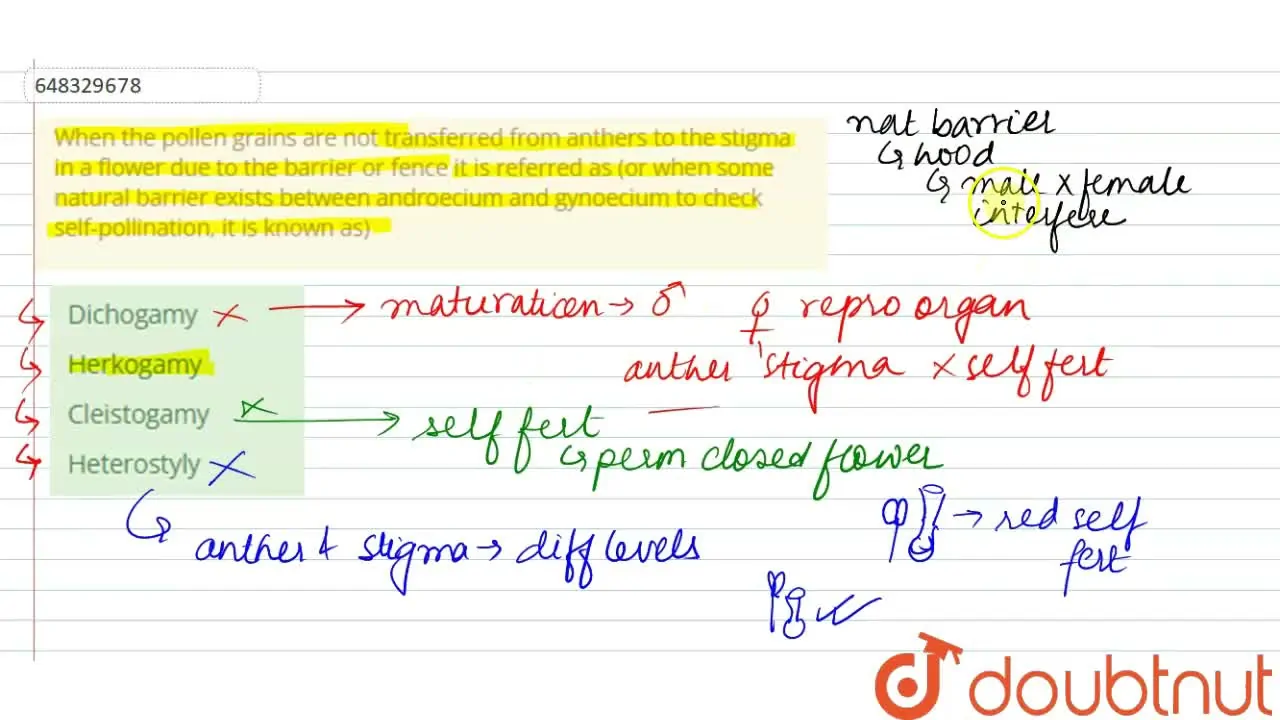When the pollen grains are not transferred from anthers to the stigma in a flower due to the barrier or fence it is referred as (or when some natural barrier exists between androecium and gynoecium to check self-pollination, it is known as)
Dichogamy
Herkogamy
Cleistogamy
Heterostyly
The correct Answer is:B
Step by step video & image solution for When the pollen grains are not transferred from anthers to the stigma in a flower due to the barrier or fence it is referred as (or when some natural barrier exists between androecium and gynoecium to check self-pollination, it is known as) by Biology experts to help you in doubts & scoring excellent marks in Class 11 exams.
Related Playlists
- BOOK - AAKASH SERIESCHAPTER - SEXUAL REPRODUCTION IN FLOWERING PLANTS EXERCISE - EXERCISE - III (Previous AIPMT/NEET Questions )61videos
SEXUAL REPRODUCTION IN FLOWERING PLANTS
- BOOK - AAKASH SERIESCHAPTER - SEXUAL REPRODUCTION IN FLOWERING PLANTS EXERCISE - EXERCISE - I (Apomixis and Polyembryony )3videos
SEXUAL REPRODUCTION IN FLOWERING PLANTS
- BOOK - AAKASH SERIESCHAPTER - REPRODUCTIVE HEALTH EXERCISE - EXERCISE-III (PREVIOUS AIPMT/NEET QUESTIONS)21videos
REPRODUCTIVE HEALTH
- BOOK - AAKASH SERIESCHAPTER - STRATEGIES FOR ENHENCEMENT IN FOOD PRODUCTIONEXERCISE - EXERCISE-III68videos
STRATEGIES FOR ENHENCEMENT IN FOOD PRODUCTION
Similar Questions
When pollen grains are not transferred from rahthers to stigma in a flower, due to the physical barrier, it is called
View SolutionNontransfer of pollen from anther to stigma of the same flower due to a mechanical barrier is
View SolutionThe transfer of the pollen grains from the anther to the stigma of a flower is called fertilization.
View SolutionTransfer of pollen grains from anther to the stigma of another flower on the same plant is called
View SolutionWhen pollen grains of a flower are transferred to stigma of another flower of a different plant, the process is called
View SolutionThe type of pollination involving transfer of pollen grains from anther to the stigma of the same flower is known as
View SolutionPollination basically refers to the transfer of pollen from the anther to the stigma . Pollination is of many types. The types of pollination depend on
View SolutionConsider the following statements with respect to the flowering plants and choose the correct option (a) Pollen grains represent the male gametes (b) Functional megaspore develops innto embryo sac that represents the female gamete (c) Transfer of pollen grains from anther to stigma of different plant is known as xenogamy (d) Transfer of pollen grains from anther to stigma of another flower of the same plant is known as geitonogamy
View Solution[A]: Pollen grains from male parent are mostly transferred to the stigma in the female parent by some external ageincy. [R]: This is because the male flowers or male organs have no intemal device to reach the female organs in another flower
View SolutionTransfer of pollen grains to the stigma of the pistil is termed as .......a........ .
II. Transfer of pollen grains from the anther to the stigma of the same flower is termed as ..........b.......
III . Transfer of pollen grains from the anther to the stigma of another flower of the same plant is termed as ........c.........
Transfer of pollen grains from the anther to the stigma of a different plant is termed as .........d......
Fill in the blanks a, b, ,c and d with given terms .View Solution


